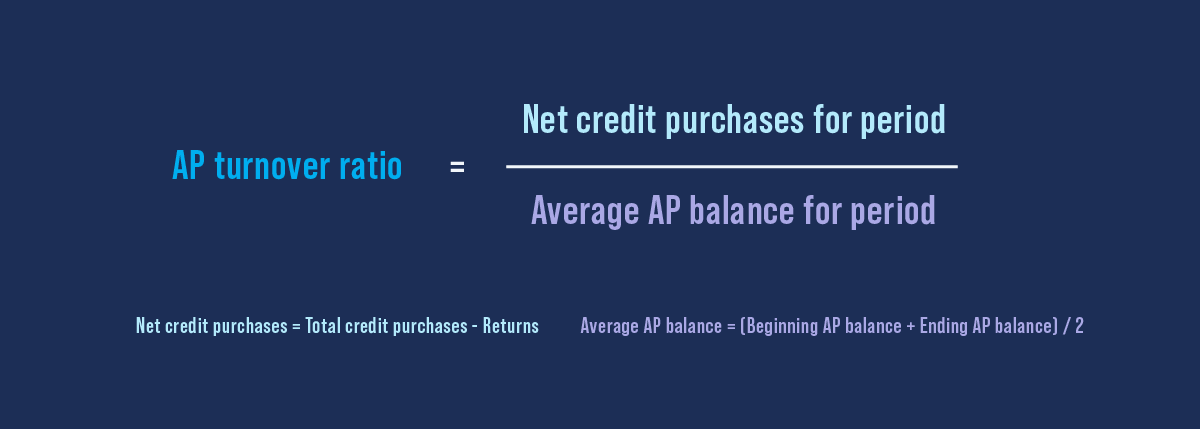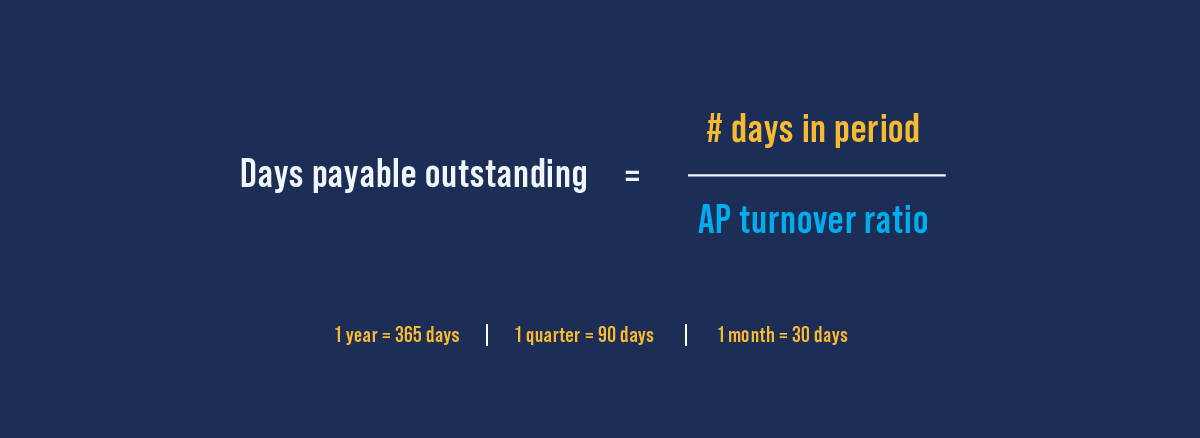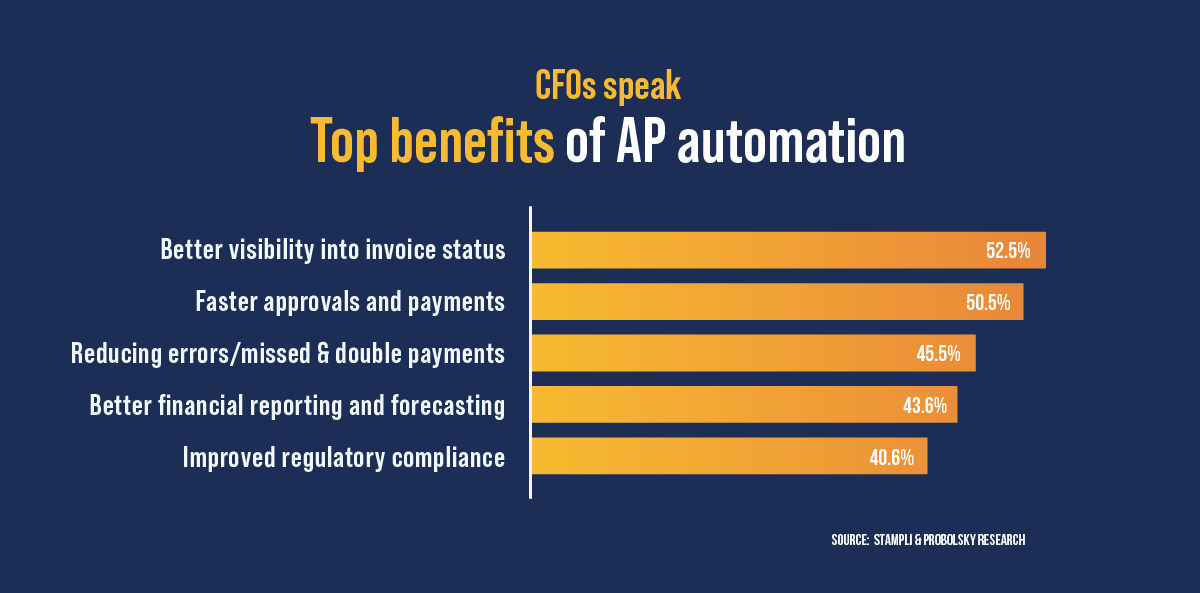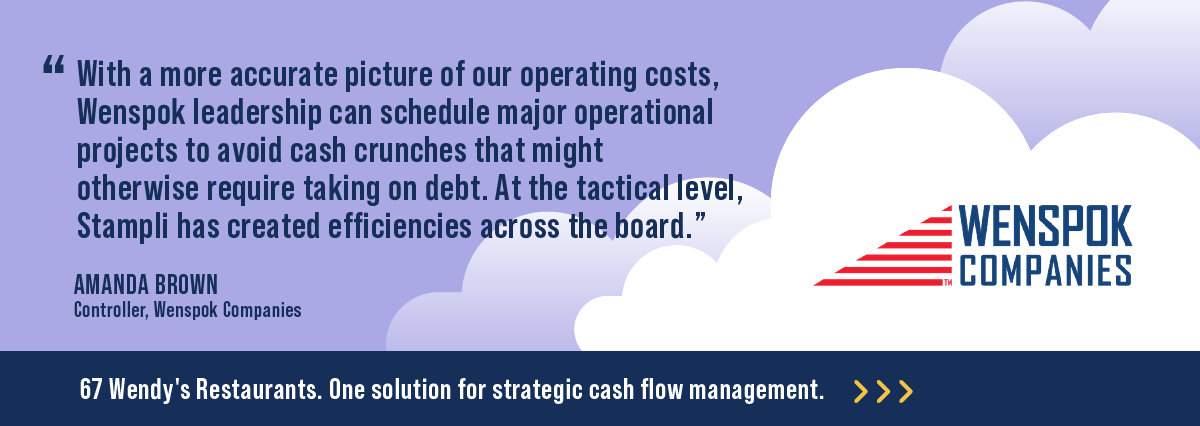The essential guide to the accounts payable turnover ratio

The accounts payable turnover ratio (AP turnover ratio) is one of the most powerful tools in the AP toolbox. It measures how quickly your business pays off its suppliers — a vital metric on short-term liquidity and how your business is maximizing cash flow efficiency.
In essence, the AP turnover ratio calculates the average number of times your business pays off its accounts payable in an accounting period. By understanding this ratio and the insights it provides, you can create strategies to optimize cash flow and strengthen your company’s financial position.
In this article, we’ll explain the AP turnover ratio, decode its insights, and show you how to use those insights to your full advantage with financial automation software.
How to calculate the AP turnover ratio
You can calculate the AP turnover ratio by dividing the net credit purchases (total purchases less returns) by the average accounts payable balance for an accounting period.
The AP turnover ratio formula is as follows:

To calculate net credit purchases, subtract the amount of returned products bought on credit from the total credit purchases for the accounting period. Be careful not to include cash purchases in the calculation.
To calculate the average accounts payable balance, add the beginning and ending accounts payable balances for the period and divide the sum by two.
Calculating Days Payable Outstanding using the AP turnover ratio
You can use the AP turnover ratio to calculate the accounts payable turnover in days, or Days Payable Outstanding (DPO), the average number of days your business takes to pay an invoice. To calculate the DPO for a period using the AP turnover method, divide the number of days in the period by the AP turnover ratio for the period.

Example of AP turnover ratio and DPO
In their last fiscal year, BTB Technologies purchased $32 million in products on credit. They also returned $1,200,000 in products to their suppliers. Their beginning AP balance for the fiscal year was $2 million, and the ending balance was $1.5 million.
Using the formula, we can calculate BTB’s AP turnover ratio:
Turnover ratio = (32,000,000 – 1,200,000)/(3,000,000 + 3,500,000)/2 = 9.4
This means that, on average, BTB pays their accounts payable 9 times per year.
BTB’s DPO for the year can be calculated as 365/9 = 40.6 days, meaning that, on average, it took 41 days to pay an invoice during the year.
Getting insights from the AP turnover ratio
After calculating the AP turnover ratio, you can use it to get insights into your company’s financial performance, AP processing, cash flow management, and vendor relationships.
On its own, the AP turnover ratio tells you how quickly your business pays its vendors. This information can provide useful insights into your spending that you can use to manage cash flow better.
To better understand your company’s overall financial performance, you can compare the AP turnover ratio to other metrics, including:
- Accounts receivable and inventory turnover ratios
- Supplier payment and credit terms
- Competitor and Industry ratios and benchmarks
Let’s look at these insights more closely.
What the AP turnover ratio says about spending and cash flow
Because the AP turnover ratio gives information about your short-term liquidity, it can be used as a valuable indicator of your company’s health. For example, prospective suppliers can use the ratio to determine if they’ll extend credit to your business, or investors could use it to assess whether your business can meet its financial obligations in the short term.
Why is the AP turnover ratio important?
The AP turnover ratio gives you valuable information about your company’s financial health, which provides several benefits:
- Better cash management: The ratio gives you the big picture of your company’s cash flow patterns. If the ratio is high, your business is paying its bills quickly, which may strain cash reserves. On the other hand, a low ratio means your business is holding onto its cash, which means your cash reserves should be healthy. However, if the ratio is very low it could indicate your business is short of cash.
- Liquidity ratio: A high AP turnover ratio may suggest your business is highly liquid, but it could also mean it might not be capitalizing on supplier credit. A lower ratio could indicate weaker liquidity, but it could mean your company is taking full advantage of supplier credit terms.
- Stronger vendor relationships: Your vendor relationships depend on how quickly you pay suppliers. A high turnover ratio means you’re paying vendors early or on time, which builds trust and could lead to better credit terms. A low ratio means you’re paying late, which may result in vendors giving less favorable terms or even withholding shipments.
- Financial risk: A very low or very high AP turnover ratio could indicate financial instability or poor cash management and raise concerns from investors or creditors. Monitoring your ratio lets you address problems before they become red flags.
What is a good accounts payable turnover ratio?
No “ideal” AP turnover ratio exists because every business is different. Businesses with favorable credit terms with suppliers may take longer to pay down their AP, so their AP turnover ratio might be low. Conversely, a cash-rich business may choose to pay its vendors quickly, meaning it will have a higher turnover ratio. As a general benchmark, a turnover ratio of 12 indicates that a business pays its invoices within an average of 30 days.
You can track your AP turnover ratio over time to identify trends and gain deeper insights into how efficiently your company is managing its payables.
A low or decreasing AP turnover ratio
A low or decreasing turnover ratio is a sign that a company is taking longer to pay suppliers. A sharp drop in the turnover rate could indicate the company is short of cash or in a dispute with a supplier. If the ratio decreases period over period, it could be a sign that the business is having trouble making payments. Alternatively, a gradual decrease could also indicate the business has negotiated different payment terms with its suppliers or is managing its cash strategically.
A high or increasing AP turnover ratio
A high or increasing ratio indicates the company is paying suppliers more frequently. A short-term increase in the ratio could indicate the company has plenty of cash and chose to pay off suppliers. Conversely, it could indicate that a supplier has demanded payment or changed to less favorable payment terms. If the ratio increases over time, it could indicate the company is managing its AP debts and cash flows effectively. However, it could also mean the company isn’t reinvesting cash into its business.
Tracking changes in the AP turnover ratio provides good insights into the financial performance of a business. However, as our examples show, the ratio doesn’t give the whole picture — several factors can cause the ratio to increase or decrease. You need to compare the turnover ratio to other metrics to gain deeper insight.
Comparing the AP turnover ratio to other metrics
The AP turnover ratio provides insight into how a company manages its accounts payable. However, it doesn’t provide context on its own. Comparing the ratio to other metrics gives you a bigger picture of a company’s performance and a more nuanced understanding of its financial health.
AP turnover ratio vs. AR and inventory turnover ratio
You can compare the AP turnover ratio to the accounts receivable and inventory turnover ratios to better understand the company’s financial health and cash flow.
Accounts receivable turnover ratio
The accounts receivable turnover measures how well a company collects money owned by customers. A high AR turnover ratio means the company’s customers pay it promptly, indicating it probably has cash on hand. A low AR turnover ratio means customers take longer to pay, meaning the company is extending credit to customers and may not have enough cash on hand.
A low AP ratio and AR ratio could indicate that the company is cash-strapped and struggling to pay its suppliers. Conversely, a low AP ratio combined with a high AR ratio could indicate that the company has plenty of cash on hand but is being strategic about paying suppliers.
Inventory turnover ratio
The inventory turnover ratio measures the rate at which stock is sold and replaced. For example, an inventory turnover ratio of 3 means that the company turned over (sold) its entire inventory 3 times in the period. A high inventory turnover ratio indicates strong sales—the company is regularly selling out and replenishing its inventory. Alternatively, a low inventory turnover ratio means sales are weak—the company isn’t selling out its inventory very quickly.
A low AP ratio and low inventory turnover ratio could indicate that the company’s revenues are declining and it’s short on cash. The low inventory ratio suggests that sales have dropped, meaning revenue is down, and the low AP ratio means that the company is taking longer to pay suppliers. High AP and inventory turnover ratios could indicate revenue is up, and the company has plenty of cash. The high inventory turnover ratio means sales are strong, and the high AP ratio suggests the company is paying suppliers on time as it replenishes its inventory.
AP turnover ratio vs. invoice payment terms
Comparing the AP turnover ratio to invoice payment terms lets you understand how your business is managing AP and cash flow. For example, say vendors are offering net 60 credit terms, and your AP turnover ratio is 12. That means you’re paying vendors within 30 days on average and may not be taking advantage of favorable payment terms. By paying vendors early, you’re either paying short-term interest or not earning income for as long as you can on your cash balances.
You can also use the AP turnover ratio to take advantage of or negotiate for early payment discounts. For example, if your ratio is higher than average (indicating you pay vendors quickly), you could use this information to help you negotiate early payment discounts with vendors.
AP turnover ratio vs. competitor and industry metrics
Benchmarking your AP turnover ratio to your competitors’ turnover ratios or the average turnover ratio for your industry is a great way to see where your company stands. It can also provide you with valuable competitive intelligence. For example, one of your competitors may be showing high revenue but a low AP turnover ratio, indicating that they may be reinvesting cash into their business rather than paying suppliers.
How to maintain a good AP turnover ratio
You can use the insights gained from calculating your company’s accounts payable turnover ratio to improve your AP and cash flow management. As mentioned, there is no “ideal” turnover ratio. However, your company’s ratio should be consistent with that of other companies in your industry.
The best way to improve your accounts payable turnover ratio is to have sound accounts payable and cash flow management practices. Here are a few things you can do at your business:
Negotiate better payment terms or early discounts
If you can negotiate better credit terms with your suppliers, it will give you more breathing room for payments and lower your turnover ratio. Conversely, you may also be able to negotiate early payment discounts that make it financially worthwhile to pay vendors quickly. Of course, the success of your negotiations depends on the strength of your supplier relationships.
Improve inventory management
Good inventory management prevents shortfalls or overstocks, allowing you to make smaller and more regular orders. Being able to forecast inventory levels makes it easier for your business to plan purchases and manage cash flow, which can lower your AP ratio.
Manage credit wisely
You can use credit to space out supplier payments and lower your turnover ratio. However, borrowing may result in higher interest costs, future cash shortages, and potential long-term debt if your business cannot repay the credit quickly.
Use accounts payable automation
Financial automation software can streamline accounts payable processes, reducing invoice and payment processing times and paying vendors faster. Leading solutions provide real-time reporting and analytics, seamless integration with ERPs, and electronic payment methods to give you total visibility and control over AP processing and cash flow management.

How to optimize AP turnover with financial automation
Financial automation platforms streamline accounts payable workflows to help businesses process invoices and pay vendors faster. They also provide accurate, real-time data that gives you actionable insights you can use to optimize cash flow management. Here’s how automation gives you control over AP turnover:
Better visibility into invoice status informs cash flow decisions
Visual dashboards and reporting features let you track invoice and payment status in real time, letting you make informed strategic cash flow management decisions.
Faster approvals and payments improve AP turnaround
Automation eliminates delayed approvals by routing invoices to the right approvers and sending reminders to keep things moving. Integrated payment processing then ensures that vendors are paid quickly after approval.
Seamless ERP integration facilitates collaboration
Financial automation systems integrate with ERPs and accounting software to provide a single source of truth for financial data and records and ensure precision in financial operations and reporting.
Reduced errors and missed payments keep vendors happy
AP automation eliminates manual invoice management and payment workflows to reduce processing errors and missed payments, saving money and building stronger vendor relationships.
By delivering on these features, leading financial automation solutions like Stampli turn accounts payable into a powerful tool for strategic cash flow management. Unlike other financial automation platforms that offer generic AP automation, Stampli is designed for the specific needs of AP departments. Its evolutionary solution goes beyond automating processes to give finance leaders the visibility and control they need to optimize AP turnover.
“I like how Stampli automates our payables cash flow,” says one Stampli customer on G2. “It increases our efficiency. The best thing about this is a centralized location for our AP flow…It allows us to have our AP flow exclusively in one place. It also allows us to get approvals in-system rather than via emails. Business performance has increased.”
Case study: Strategic cash flow management for Wenspok Companies
Wenspok Companies is a Wendy’s franchise group operating 67 restaurants across the Pacific Northwest and Midwest. With revenues exceeding $150 million, Wenspok prioritizes precise and efficient financial management practices. For Wenspok, every accounts payable transaction is a data point that informs strategic cash flow management.
Wenspok’s business centers on proactive cash flow management. “With a more accurate picture of our operating costs, Wenspok leadership can schedule major operational projects with confidence in budgeting and timing of cash flow requirements,” said Amanda Brown, Wenspok Companies’ controller. “For Finance to meet these expectations, we need to process invoices fast.”
Wenspok came to Stampli with two challenges:
- A need to dramatically increase their invoice processing speed to provide their business with strategic cash flow guidance.
- A financial automation solution that integrates so well with Sage Intacct that it would feel “almost like magic.”
Stampli’s implementation team worked with Wenspok’s finance team to set up financial automation across Wenspok’s 67 Wendy’s restaurants. They integrated Stampli with Wenspok’s Sage Intacct system to seamlessly share data and communications and enable the strategic cash flow management Wenspok needed.
As a result, Wenspok reduced invoice processing time from 27 to 8 days, a 75% decrease. “We cash flow all our remodels or new builds,” said Amanda. “so we need visibility on the operating costs that are being incurred at the same time to be effective in our financial guidance. Stampli allows for us to more accurately project cash flow, which helps us provide drastically better financial guidance to our owners.”

Wenspok also achieved an 87% reduction in average days to approve invoices and a 73% faster monthly close on credit cards. “We can process transactions daily,” said Amanda. “so we have visibility into outstanding transactions. We can pull reports to target communications to anyone with outstanding issues. We’ve even increased the number of receipts attached to transactions by 65% — which, like all the other features, gives us that strategic visibility into cash flow.”
By providing Wenspok with greater processing efficiency, improved visibility into transactions, and seamless integration with Sage Intacct, Stampli helped them optimize their strategic cash flow. Stampli’s impact has been felt well beyond AP automation — it has become a critical element of Wenspok’s operational strategy.
Stampli: The only financial automation solution designed for AP
Stampli is designed by AP professionals for AP professionals.
It’s the smartest and fastest financial automation platform on the market and an ideal choice for businesses wanting to turn AP into a strategic driver.
The demands on Accounts Payable (AP) teams are increasing. Efficient cash flow and liquidity management are crucial for business growth. Stampli offers pre- and post-implementation support, along with resources to help you optimize your AP automation solution and potentially improve working capital management.
“The best aspect of Stampli is its seamless automation of the accounts payable process,” says a Stampli customer. “The intelligent invoice processing and approval workflows have significantly streamlined our operations, saving time and reducing manual errors…Limited visibility into the status of invoices and a lack of a robust audit trail made it challenging to track and manage financial transactions effectively. Stampli provides a transparent and traceable audit trail, allowing us to monitor the status of invoices at every stage.
“Disparate systems and manual data entry caused inconsistencies and inefficiencies in data management. Stampli’s integration capabilities with other systems help to create a more seamless and connected financial ecosystem.”
Take control over your payables to get the visibility and control you need to better manage your cash flow. Contact a Stampli expert today for a free demo.